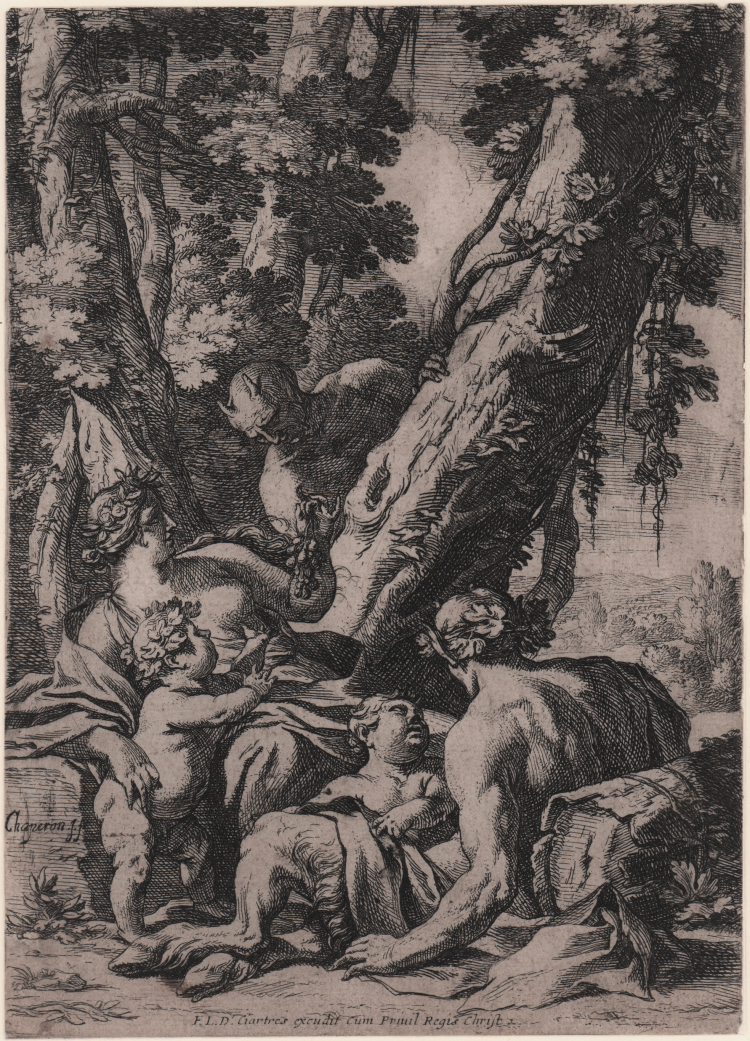




| Reference: | S9039 |
| Author | Nicolas CHAPERON |
| Year: | 1640 |
| Measures: | 165 x 230 mm |



| Reference: | S9039 |
| Author | Nicolas CHAPERON |
| Year: | 1640 |
| Measures: | 165 x 230 mm |
Etching with engraving, circa 1640.
Draped woman resting with two young children and a satyr in the shade of a tree; the woman, holding a bunch of grapes in her hand, is talking to a satyr standing behind the tree.
A fine impression, printed on contemporary laid paper, trimmed to the borderline, good condition.
Form the set called 'Recueil de diverses Bacchanales', engraved by Chaperon and Dorigny (among others) and representing dionysiac scenes; the plates described by Robert-Dumesnil (IV.254.12-17) are all anonymous and it is therefore difficult to attribute them with certitude.
Nicolas Chaperon was ranked by Pierre-Jean Mariette among Simon Vouet's most accomplished pupils. After completing his apprenticeship in Vouet's large Paris workshop, Chaperon was seduced by the refined classicism of Nicolas Poussin, whom he may have met in Paris and certainly knew in Rome. In around 1640-2, Chaperon travelled to Rome where he worked under Poussin for François Sublet de Noyers in the Galleria Farnese. Chaperon's technique was so indebted to Poussin that paintings by the former, such as his Nurture of Jupiter (Ackland Art Museum, Chapel Hill, NC; fig. 1), were engraved as works by Poussin as late as the nineteenth century. Their professional relationship in Rome was short-lived, and by 1644 Chaperon was documented in Malta, possibly as a result of a dispute with the master. In 1649 Chaperon returned to Rome, where he published a series of engravings after Raphael's frescoes in the Vatican Loggie, generally considered the finest engravings after the celebrated cycle. Chaperon, like Poussin, would spend his final years in Rome, never returning to his native country.
Bibliografia
Inventaire du Fonds Français: Bibliothèque Nationale, Département des Estampes, Paris, 1930, 57; Robert-Dumesnil VI.231.57.I.
Nicolas CHAPERON (Châteaudun 1612 - Lyon 1656)
|
Nicolas Chaperon (bapt. 19 October 1612, in Châteaudun – 1656 in Lyon) was a French painter, draughtsman and engraver, a student in Paris of Simon Vouet whose style he adopted before he was further matured by his stay in Rome (1642–51) in the studio of Nicolas Poussin.
Nicolas Chaperon was ranked by Pierre-Jean Mariette among Simon Vouet's most accomplished pupils. After completing his apprenticeship in Vouet's large Paris workshop, Chaperon was seduced by the refined classicism of Nicolas Poussin, whom he may have met in Paris and certainly knew in Rome. In around 1640-2, Chaperon travelled to Rome where he worked under Poussin for François Sublet de Noyers in the Galleria Farnese. Chaperon's technique was so indebted to Poussin that paintings by the former, such as his Nurture of Jupiter (Ackland Art Museum, Chapel Hill, NC; fig. 1), were engraved as works by Poussin as late as the nineteenth century. Their professional relationship in Rome was short-lived, and by 1644 Chaperon was documented in Malta, possibly as a result of a dispute with the master. In 1649 Chaperon returned to Rome, where he published a series of engravings after Raphael's frescoes in the Vatican Loggie, generally considered the finest engravings after the celebrated cycle. Chaperon, like Poussin, would spend his final years in Rome, never returning to his native country.
|
Nicolas CHAPERON (Châteaudun 1612 - Lyon 1656)
|
Nicolas Chaperon (bapt. 19 October 1612, in Châteaudun – 1656 in Lyon) was a French painter, draughtsman and engraver, a student in Paris of Simon Vouet whose style he adopted before he was further matured by his stay in Rome (1642–51) in the studio of Nicolas Poussin.
Nicolas Chaperon was ranked by Pierre-Jean Mariette among Simon Vouet's most accomplished pupils. After completing his apprenticeship in Vouet's large Paris workshop, Chaperon was seduced by the refined classicism of Nicolas Poussin, whom he may have met in Paris and certainly knew in Rome. In around 1640-2, Chaperon travelled to Rome where he worked under Poussin for François Sublet de Noyers in the Galleria Farnese. Chaperon's technique was so indebted to Poussin that paintings by the former, such as his Nurture of Jupiter (Ackland Art Museum, Chapel Hill, NC; fig. 1), were engraved as works by Poussin as late as the nineteenth century. Their professional relationship in Rome was short-lived, and by 1644 Chaperon was documented in Malta, possibly as a result of a dispute with the master. In 1649 Chaperon returned to Rome, where he published a series of engravings after Raphael's frescoes in the Vatican Loggie, generally considered the finest engravings after the celebrated cycle. Chaperon, like Poussin, would spend his final years in Rome, never returning to his native country.
|